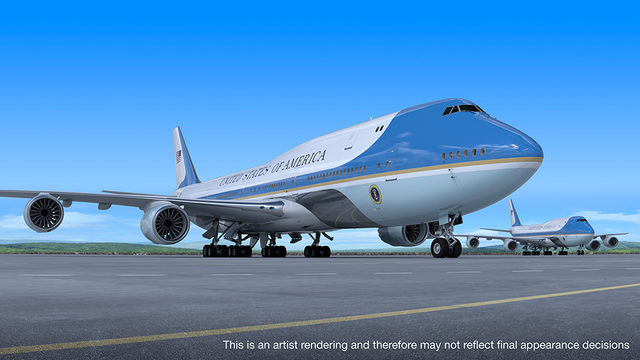The VC-25B, or “Air Force One,” replacement will be as late as 36 months, and members of the House Armed Services Committee warned USAF that they plan to push for competition on the KC-Y stage of aerial tanker recapitalization, which Air Force Secretary Frank Kendall has said the service may skip.
Air Force acquisition executive Andrew P. Hunter, testifying before the HASC power projection panel, said the VC-25B is “anticipating a delay to the previously approved schedule on the order of 24-36 months …[or] two to three years.” The previous estimate had been 17 months late.
It’s “quite a significant delay,” he said.
Boeing is the sole-source contractor for the VC-25B and is converting two 747-8s for the job. Hunter said Boeing’s subcontractor to do the interior finishing couldn’t do the work, a problem that’s “been known for some time,” but it’s taken further effort to assess the full effect of that setback on the schedule.
Boeing “had to bring in someone else to do that work” and take some of it in-house, Hunter said.
The two- to three-year delay in initial operational capability “means we will have to sustain the existing aircraft longer,” Hunter said, warning the committee that it will see changes in the fiscal 2024 budget submission to that effect as well as a request for “further resources to cover the gap.” The existing VC-25A fleet is more than 30 years old and suffers from “vanishing vendor” parts issues and general obsolescence, and has already been extended in service.
He added that “I believe we can take care of it within the resources within the program.”
An Air Force spokesperson said the delay “is due to a combination of factors,” including “impacts from the COVID-19 pandemic,” the change of vendors for the interior work, “wiring design timelines and test execution rates.” She said the Air Force “currently expects a 24-month delay” in the program.
The Air Force “recommends” that the “objective”—or goal delivery time—should be set at 24 months, while the “threshold,” or must-have, be set at 36 months, the spokesperson said. The Pentagon’s acquisition and sustainment chief, William LaPlante, will decide on the timing after “an update to the acquisition program baseline,” she said.
“Based on how the contract was written, as the expected completion date moves to the right, the threshold date also moves to the right,” she noted. “The new schedule baseline will contain the updated completion timeline.”
Hunter was warned by several members of the committee that they are unhappy with Kendall’s recent comments that the KC-Y phase of tanker recapitalization may simply be a sole-source to Boeing, and that they will push hard for a competition on that phase.
Rep. Rob Wittman (R-Va.) noted that Kendall has called competition an important tool for driving both quality and lower costs and asked Hunter why the Air Force is “walking away” from that idea on the tanker.
Rep. Jerry Carl (R-Ala.) said the HASC would “go ballistic” in the absence of a competition. Lockheed Martin has said that if it wins the KC-Y contest with its LMXT tanker—based on the Airbus A330 Multi-Role Tanker Transport—it would build the jet in Alabama.
Kendall told reporters on the eve of the fiscal 2023 budget rollout in March that “I want to be very transparent about this. I think that there’s still a possibility of competition out there, but as we’ve looked at our requirements, the likelihood of competition has come down.” Near-term, the requirements for KC-Y “start to look like a modified KC-46 more than they do a completely new design.” The service had previously said it views the KC-Y as a “bridge tanker” to a next-generation aircraft.
Hunter said the Air Force is still “gathering data” on what the KC-Y requirements should be and that the process will be completed in the fall, when a decision will be made as to whether to compete the KC-Y, which will replace both KC-135s and KC-10s.
“We are awaiting inputs from the requirements community,” Hunter said.
There could be “some difference” in the near-term versus long-term requirements for new tankers, Hunter said.
The three-stage KC-X, KC-Y, and KC-Z plan for tanker recapitalization “was formulated probably a decade ago, and the environment has evolved substantially since then,” Hunter said.
The need for “something like KC-Z”—which has notionally been described as a potentially stealthy, next-generation type of aircraft—“is growing more urgent over time, and that’s definitely part of our calculus,” Hunter noted.
However, “we want to deliver capability the warfighter needs in the 2020s timeframe.” That would likely mean sticking with the KC-46 for the next tranche of tanker replacement.
Carl pointed out that Boeing has had severe problems with the KC-46 and claimed that “it only works 85 percent of the time,” conflating mission capability with the fact that the Pegasus is now certified for 85 percent of the planned list of aircraft it’s supposed to be able to refuel. He also pointed to delays on Boeing’s T-7 trainer, a new cost increase on the B-52 re-engining, and the Air Force One delay and said “I’m extremely concerned” about the Air Force “putting all its eggs in one basket” with the tanker.
“Somehow … we still feel comfortable putting all this business in their lap,” he said, adding, “that’s dangerous.”
Carl said the KC-46 “can’t compete” with the “Airbus/Lockheed plane” and insisted that the tanker program be “re-bid.”
Lockheed Martin announced this week that it would build the automated boom for the LMXT in Arkansas.
Rep. Donald Norcross (D-N.J.), whose district includes Joint Base McGuire-Dix-Lakehurst, said buying more KC-46s would get the Air Force more tankers to deal with Pacific theater threats “in the 2027” timeframe.
